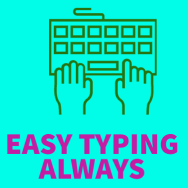Type In Bangla
Type In English, Get In Bangla
Your Ad Here
About our Bengali typing and translation software:
After you type a word in English and hit a space bar key, the word will be transliterated into Hindi. You can also hit a backspace key or click on the selected word to get more options on the dropdown menu.
The process of transliterating Hindi to English is very quick and allows unlimited characters and words to be transliterated.
Our Easy Hindi Typing is really simple and easy to use as you don’t need to remember complex Hindi keyboard layout or practice Hindi typing for days and days to be able to type fluently in Hindi.
Once you have finished typing you can email them to anyone for FREE of cost. Alternatively, you can copy the text and share it either on social media such as Facebook, Twitter, blog, comment or paste it on the Word Document for further formatting and processing of the text.
If you have any suggestions or feedback then please leave a comment on our Facebook page. Finally, but most importantly, please like and share our page on Facebook with your loved one.
Bengali /bɛŋˈɡɔːli/ (Bangla [ˈbaŋla] is an eastern Indo-Aryan language native to the eastern region of South Asia known as Bengal that comprises of Bangladesh, the some states of India such as West Bengal, Assam and Tripura. There are over 220 million native speakers with additional 30 million non-native speakers bringing it to over 250 total speakers making it one of the most spoken languages (ranked sixth) in the world. The national anthem of Bangladesh, The National song and the national anthem of India is composed in Bengali.
Bengali evolved during 1000–1200 CE from eastern Middle Indo-Aryan dialects such as the Magadhi Prakrit and Pali, which developed from a group of dialects that were close to Vedic and Classical Sanskrit. Literary Bengali saw borrowings from Classical Sanskrit, preserving spelling while adapting pronunciation to that of Bengali, during the period of Middle Bengali.
Bengali binds together a culturally diverse region and is an important contributor to Bengali nationalism. In former East Bengal, known today as Bangladesh, the love for the language led to the Bengali Language Movement. During this movement, on 21 February 1952, several people were killed during protests to gain its recognition as a state language and to maintain its writing in the Bengali script.
Bengali arose from eastern Middle Indo-Aryan dialects of the Indian subcontinent. Magadhi Prakrit and Pali, the earliest recorded spoken languages in the region and the language of Gautama Buddha born in Nepal, evolved into the Jain Prakrit or Ardhamagadhi in the early part of the first millennium CE. Ardhamagadhi, as with all of the Prakrits of North India, began to give way to what are called Apabhraṃśa (“Corrupted grammar”) languages just before the turn of the first millennium. The local Apabhraṃśa language of the eastern subcontinent, Purvi Apabhraṃśa or Abahatta (“Meaningless Sounds”), eventually evolved into regional dialects, which in turn formed three groups: the Bihari languages, the Oriya languages, and the Assamese-Bengali languages.
Characters Set (Alphabets and Numerials):
Bengali character set is divided into 21 vowels, 36 consonants and modifiers. The vowels themselves can be divided into dependent and independent vowels. Along with consonants and vowels there are some special modifiers such as Virama, Candrabindu, Anusvara, Visarga. Furthermore, it also has its own numerals.
Text Processing:
The Independent vowels can be combined with consonants in different manners. For example, it can be joined to right, left, and also above and below. In old type-writers and non-standard Bengali encodings, the vowels that are attached to the left character are written first followed by consonant. The Unicode Standard requires typing order on the script consonant and vowel rather than other way around. This applies whether the vowel visually appears after or before the constant. For the rendering process the visual placement is handled separated. Therefore, if the Unicode encoding process is followed, no reordering of the characters is required.


